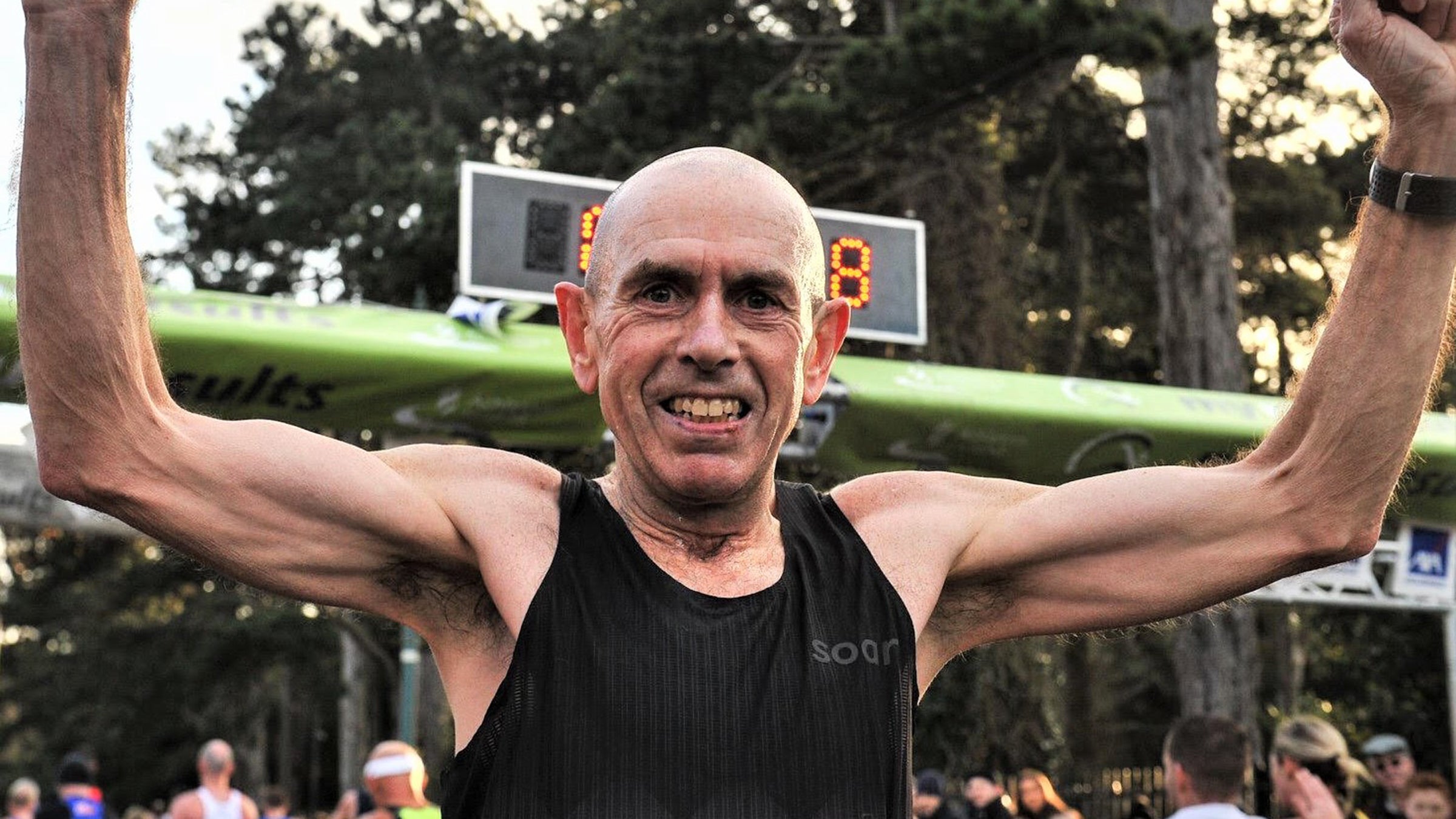Tommy Hughes ran two remarkable marathons last year. In April, the 59-year-old Irishman clocked a 2:30:15 in the Rotterdam Marathon. Six months later, he ran even faster. His 2:27:52 in the Frankfurt Marathon on October 27 gave him the world record for his age.
And it wasn’t his only world-record for the day. Hughes’s 34-year-old son, Eoin, finished Frankfurt, his first marathon, in 2:31:30. Their combined time, 4:59:22, made them the Guinness-ratified record holders for fastest father-son marathoners.
Though Hughes is 10 years younger than Ed Whitlock and Gene Dykes at the time of their best age-70+ performances, his score on the globally recognized age-graded-calculator is higher. He gets a 102.57 for his Frankfurt effort. Whitlock ran 2:54:48 at age 73, good for a 100.78. Dykes ran 2:54:23 at age 70 to score a 97.42.
The current record for an over-60 marathon according to ARRS.run is 2:36:30. Hughes hopes to attack that mark this fall in whatever marathon he can find post coronavirus. Last year, he submitted to physiological lab testing twice in Liverpool, England (journal articles here and here.) The researchers subsequently calculated that he should be able to run 2:49 at age 70 if he can maintain form. (See the end of this article for some of Hughes’s test results.)

Hughes, who turned 60 in January, has had two running careers, almost three in one sense, the latest being just two years old. In his first, he achieved a PR of 2:13:59, and ran in the 1992 Barcelona Olympics. After Barcelona, he retired from running for 16 years to concentrate on family and work. In 2008, he started up again at age 48. In his comeback marathon that year at age 48, he clocked an impressive 2:28.
Over the next four years, he ran several more sub-2:30s. But by 2014, his times had drifted up to 2:36. Worse, he began to feel lethargic and depressed, enough so that he stopped entering marathons. In 2017, after what Hughes calls a three-month alcohol binge, his family forced him to visit a medical clinic. “It was practically the first time I had ever been seen by a doctor,” he admits.
A blood test revealed that he had sky-high levels of parathyroid hormone, which leads to high blood calcium, and a number of debilitating and dangerous symptoms. After surgery in 2018, he felt his old self almost immediately. And he began training again with the vigor he had enjoyed a decade earlier. This was his third shot at a running career.
Hughes has made good on the opportunity. Here are the training and racing principles that he relies upon:

Run only as many miles as you can handle.
In his 20s, Hughes pushed his training as high as 140 miles a week. That didn’t work. “I found that I was getting these little injuries all the time,” he remembers. Eventually, he settled on about 100 miles a week. In the last year, he’s been able to go higher—up around 120 miles a week. “I’m actually doing more miles now than when I was young,” he notes.
Do most of those runs at a modest pace.
From Monday through Friday, Hughes runs twice a day, roughly 10 miles (or a little less) at a time. On these runs, he generally holds a steady “three-quarters effort,” and says he can’t stand running slower than that. He pegs his typical running pace at 6:30- to 7:00 minutes per mile. That’s about a minute-per-mile slower than his marathon race pace, so not a hard effort.
Go past 20 on long runs.
Hughes generally follows a 12-week buildup for his marathons. During that period, he’ll run as long as 26 miles two to three times. He’ll also do several runs of 22 to 24 miles. He doesn’t push particularly hard on the long runs, but might run progressively faster the last three to five miles. (Note, at his training pace, none of these runs last longer than 3 hours).
Refine your focus.
If there were a mantra to describe Hughes’s approach, it would be: Everything’s aimed at marathon performance. Even in his 20s, he never ran faster than 14:26 for 5000 meters. “I learned early that the marathon was my best event,” he says. “And once I did, I decided to put everything into building myself to a marathon peak.”

Skip the speedwork. But race often.
Hughes does very little speedwork, fearful that the extra intensity might lead to injury. However, he races almost every weekend, either in a local Parkrun or a nearby road race. And when he goes to a start line, he goes all-out: “I love competing, and I always give one-hundred percent,” he says.
Use your races as marathon simulations.
That said, he doesn’t run his weekend races on fresh legs. “I run 10 miles early on the morning of my races,” he says. “I want to be doing my races on fatigued legs, because that’s the best way to accustom them to the late miles of the marathon.”
Keep trying to improve your training regimen.
Hughes has stuck with certain approaches most of his life—for example, the lack of track work. Otherwise, he’s always fiddling with what he calls his “training recipe,” hoping to find a new ingredient. He’s doing more foam-rolling of late, especially on his upper back and neck, which tend to get tight in marathons. He’s added a modest strength-building unit to his garage-gym, where he also practices rope-skipping and punching-bag sessions. A few years back, he started drinking a small glass of beet juice every day, and has become a big fan.
Carbo-load the hard way.
Before his big Frankfurt Marathon effort last fall, Hughes followed the old-fashioned, extreme depletion-and-repletion system of carbo-loading. He ran a hard long run seven days before the marathon (“Bleeding out,” he called it), followed by three days of a high-protein, low-carb diet. Only after this glycogen-depletion stage did he switch to a high-carb diet. “It seemed to push my glycogen up higher than normal,” he observes.
Use a short stride.
Hughes never had to work at this one. Short has always been natural for him. He ran Frankfurt with an average stride rate of 199 strides per minute. (It’s not genetic; his son used 174 strides/minute.) Hughes believes his short stride is an efficiency asset in the marathon, and also helps keep him injury-free.

Run even-pace marathons, or a slight negative-split.
It’s the almost-universal strategy these days, and Hughes is definitely on board. He practices even-pace marathon racing. At Frankfurt, he ran 1:14:22 and 1:13:40. His son made the typical rookie mistake: He ran 1:12:54 and 1:18:36. Tommy caught him at 23 miles, patted him on the back, asked “You okay?”—then motored away.
Ride the 4% wave.
Hughes, who is unsponsored, ran the Frankfurt Marathon in Nike Vaporfly NEXT% shoes. Why not? If you’re aiming for fast marathons these days, it’s what many do. “They seem to leave my legs less beaten up late in the race,” he notes, echoing what others have said.
Believe.
The longer the distance you’re racing, the more important your confidence in mastering that distance. Hughes has always focused exclusively on the marathon. Over the years, he’s learned how to train for and race the distance. “I don’t want to sound too much like Eliud Kipchoge, but I believe in myself,” he says. “I believe I can run faster. I believe I can go under 2:27 at age 60.”
Tommy Hughes, by the numbers
Lives in: Gulladuff, Northern Ireland
Born: Jan. 8, 1960
Height: 5’ 6.5”
Weight: 135 lbs
Stride rate: 199
VO2 max: 65.4 ml/kg/min
% VO2 max in marathon: 90.9
Max heart rate: 165
% Max HR in marathon: 93
Best marathon in the 1980s: 2:19:49 (1985)
Best marathon in the 1990s: 2:13:59, PR (1992)
Best marathon in the 2000s: 2:28:38 (2008)
Best marathon in the 2010s: 2:27:52 (2019)


